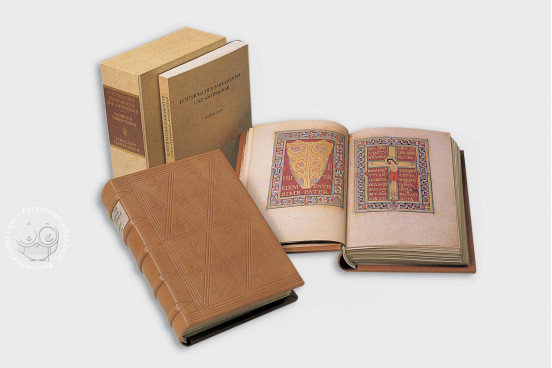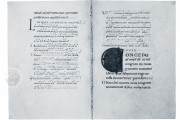The Echternach Sacramentary and Antiphonal is a Christian liturgical book copied at the Benedictine monastery at Echternach around 1030. Its painted embellishment comprises a full-page dedication miniature, nine pages of text in gold on russet-painted parchment with painted frames, and twenty-nine decorated initials. The nearly full-page representations of the crucified Christ and the Lamb of God on two of the decorated text pages and the imposing figure of Christ blessing in the dedication miniature are exemplary expressions of the solemnity of Ottonian illumination.
The dedication miniature (fol. 18v) depicts Christ with an enormous golden cross-nimbus against a glimmering gold ground, situating him—despite the hillock on which he stands—in an otherworldly and timeless realm. Holding a book in his outstretched left hand, he extends his right hand to confer a blessing on a kneeling monk.
Gold and Purple
Large areas of reddish-brown paint imitating purple-dyed parchment of late antique luxury manuscripts and gold dominate the illumination of the Echternach manuscript. The pages painted in the ersatz purple all feature thick painted frames with geometric or floral patterns in bright colors. Gold is used both for text in display script on these pages and in the interlace initials throughout the manuscript, some of which feature animal-head terminals.
Accent on the Canon of the Mass
One of the manuscript's decorative accents appears at the opening of the Te igitur, the first prayer of the Canon of Mass, the prayers accompanying the preparation of the Eucharistic elements (fols. 11v-12r). A nearly full-page T with interlace embellishment opens the prayer on the left-hand page. The text continues in monumental Square Capitals on the two facing pages, and the right-hand page is dominated by a representation of Christ on the Cross, his eyes closed in death while blood from the wounds in his feet is collected in a chalice.
Textual Innovation
The Echternach manuscript is unusual for including both the chants sung by the choir and prayers said by the celebrating priest at Mass. They are presented in annual liturgical order beginning with Advent, the season of preparation for Christmas. This is an impractical arrangement for the celebration of the rite, and the book must have been conceived more as a repository for the monastery's liturgy than as a book for use at Mass.
Honoring the Founder
The feast of the monastery's founder, Saint Willibrord (d. 739), is given a particular accent (fols. 230r-231v). Many special prayers are included for this feast, more than any other, and this is the only feast with three painted initials.
Melodies on Parchment
As was customary at the time, the texts of the chants are written at about half the scale of the prayer texts. This allowed for the inclusion of the melodies, which are written above the texts in neumatic notation, the neumes representing the contour but not the exact pitches of the melodies.
Early Additions
A single scribe wrote the main text in Caroline Minuscule. The script is especially spacious in the larger text of the prayers. After the main text was finished, six more scribes—most writing around 1100—added more liturgical texts.
A Renowned Private Collection
The Echternach manuscript was in the famous art collection of Johann Wilhelm Carl Adolph von Hüpsch (1730-1805) of Cologne. It was one of at least three illuminated manuscripts Hüpsch acquired from Jean-Baptiste Maugérard (1735–1815). Through Ludwig I (1753-1830), Grand Duke of Hesse-Darmstadt, the manuscript came to the Hessische Landes- und Hochschulbibliothek (since 2004 the Universitäts- und Landesbibliothek Darmstadt).
We have 1 facsimile edition of the manuscript "Echternach Sacramentary and Antiphonal": Das Echternacher Sakramentar und Antiphonar facsimile edition, published by Akademische Druck- u. Verlagsanstalt (ADEVA), 1982
Request Info / Price

